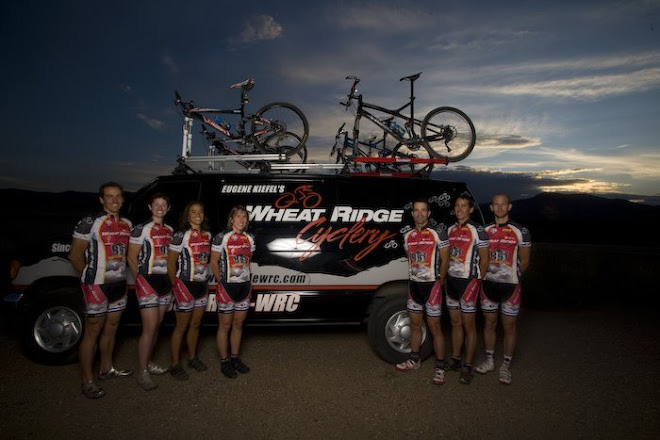Thursday, February 21, 2008
NEW Elite Xterra Team for 2008
The goal of the team is to promote the healthy and successful lifestyle that the sport of triathlon cultivates. The eight athlete team represents a unique blend of professional and elite amateur athletes of both genders and all age-groups. All EPC/WRC athletes are committed to inspiring and encouraging others to strive for excellence in every aspect of life by demonstrating courage, persistence and perseverance in the sport of Xterra Triathlon.
The focus of the team is on the 2008 Xterra National and Mountain Regional events. Goals include Regional and National championships for our amateur athletes and top five overalls nationally for our professionals. To accompany the Xterra events EPC/WRC Elite Team athletes will also participate in several road triathlons, mountain bike races and running events throughout the season.
Currently sponsors include Specialized Bicycles and Equipment, Powerbar Nutrition, and SKINS. Other sponsors are in the works. Follow our team as they train, travel and race throughout the nation on the Xterra Tour.
2008 EPC/WRC Elite Xterra Team Roster
1. Cody Waite, Pro Men
2007 7th place overall Xterra USA Tour, 5th place Mountain Championships
2. Sara Tarkington, Pro Women
2007 9th place overall Xterra USA Tour, 5th place Crested Butte, 12th Worlds
3. Luke Jay, M25-29
2007 Xterra Regional Champion, 1st AG Crested Butte
4. Ed Oliver, M35-39
2005-7 Xterra Regional Champion, 2nd AG Crested Butte
5. Rickey Tolliver, M40-44
New to Xterra, Expert mountain bike racer
6. Cary Kinross-Wright, F35-39
Ironman competitor, 2007 1st Place Xterra Crested Butte
7. Julie Bruckman, F30-34
2nd AG Xterra World Championships 2007
8. Kathy Placchi, F50-54
Past Xterra Competitor making a comeback - watch out!
Check in for updates on the team throughout the season including event schedules, race reports and other fun stuff!
Saturday, February 2, 2008
Testing Time, Tips For Determining Your LT.
For most athletes February is the perfect time for some physiological testing, more specifically, testing to determine your current Lactate Threshold (LT). The point at which you body can no longer keep up with metabolizing the lactic acid be produced from high intensity activity and lactic acid begins to accumulate in the blood stream is what is referred to as your LT. When at your LT there are heart-rate and power numbers that correlate to this point. From these HR and power numbers training zones can be created to help you train more specifically and effectively.
Hopefully by this time of the year you now have a month or two of general aerobic training under your belt since finishing your end of season break from the previous year. During this relatively low level of fitness time of the year is an ideal time to get tested so you can identify your training zones for the coming months of more structured training. It is then a good idea to perform subsequent LT tests every 4-8 weeks so you can adjust your training zones as you become more fit resulting in a higher LT.
Now, there are two ways to determine your Lactate Threshold. One is to have it tested in a lab by a physiologist. Your second option, and often just as effective, is to perform a field test on your own. I’ll focus on the field tests for cycling and running, as it is more commonly used. Having performed many lab tests my self throughout the years and comparing them to field tests, I have concluded that my field tests have always been within 2-3 beats of the HR and 4-10 watts of the power numbers correlating to my LT. Pretty darn close and close enough for me. Below you’ll find one method of how to perform LT field tests for each sport.
Cycling
For the bike test you will be performing an all-out time trial. Ideally you should perform this time trial on a steady grade. The duration should be between 20 and 30 minutes. Be sure to find a location that has low-traffic and you can ride steady for the entire duration. Your average HR and average power for the time trial will result in your LT HR and your LT power or Functional Threshold Power (FTP) (H.Allen). Be sure to pace yourself by going out a bit easy and building the effort to max by the end of the interval. If you go out too hard and blow-up, the test data is comprimised.
Running
A 3 mile all-out time trial on a flat section of road or on the track is the protocol for this test. This is similar to the bike test in that it will take most athletes 18-25 minutes to complete the test. Your average HR and pace per mile will result in your LT HR and LT pace. Just with the bike test, be sure to pace yourself so you don't blow-up before the end of the interval.
Once you have your test results in hand you can use the percentages below to determine your own HR training zones. As stated earlier, you’ll want to re-test every 4-8 weeks so you can monitor your improvements and adjust your training zones accordingly. For every re-test be sure to perform the test on the exact location every time so your comparisons can be as accurate as possible.
Heart Rate Training Zones
Zone 1: (65-77% LT HR) Active Recovery – very little lactate is being produced
and the body can clear it easily, this intensity of training helps remove any
remaining lactate from a previous session and increases blood flow just enough
to help the athlete recover
Zone 2: (78-88% LT HR) Extensive Endurance – mild to moderate amounts of lactate
are being produced and the body can clear it easily, an athlete can maintain
this pace for 2-6 hours, goal is to build aerobic endurance, this is the bulk of
most triathletes training intensity
Zone 3: (89-94% LT HR)
Intensive Endurance, Tempo – moderate to high amounts of lactate are being
produced and the body is just able to clear it, an athlete can maintain this
pace for anywhere between 1-4 hours depending on fitness level, goal is to
involve more fast twitch muscle fibers
Zone 4: (95-102% LT HR)
Sub-Threshold – this is the maximum point where an athlete can process the
lactate being produced and small amounts begin to accumulate, can maintain this
intensity 45-75 minutes depending on fitness level of athlete, goal is to
increase LT and maximal aerobic capacity
Zone 5: (>102% LT HR)
Super-Threshold, VO2 – at this intensity level the body can no longer process
all the lactate being produced and lactate accumulation is happening rapidly,
generally an athlete can maintain this pace for less than 10 minutes, goal is to
increase anaerobic endurance and power
Now armed with your appropriate HR training zones you can begin to implemet your structured base training for your coming season. By using these various training zones in your weekly training schedule you can maximize your results while keeping your training fun and more interesting at the same time. Now put the calculator away and go ride!
CW












